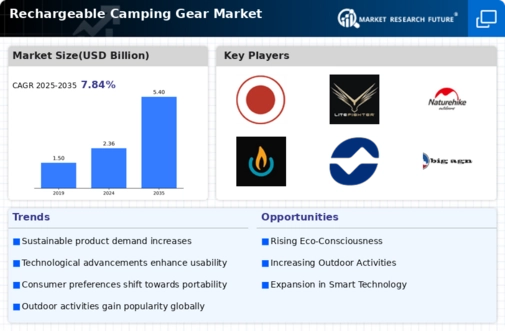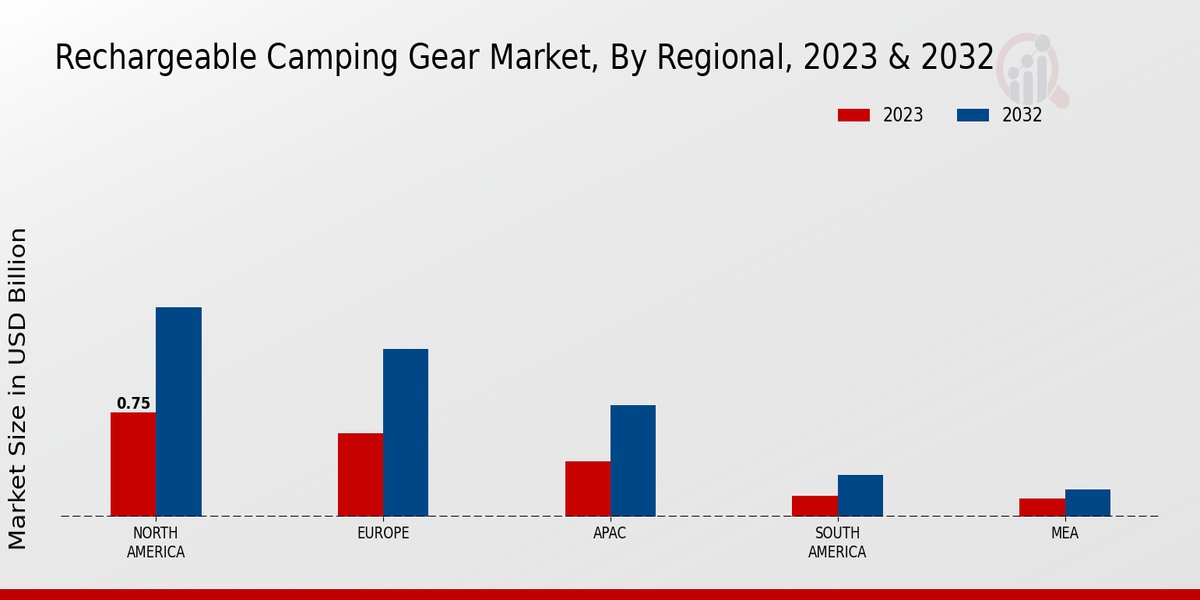Market Growth Projections
The Global Rechargeable Camping Gear Market Industry is poised for substantial growth, with projections indicating a rise from 2.36 USD Billion in 2024 to 5.4 USD Billion by 2035. This growth trajectory suggests a robust demand for innovative and sustainable camping solutions, driven by various factors such as technological advancements, increased outdoor participation, and rising environmental awareness. The anticipated CAGR of 7.82% from 2025 to 2035 highlights the industry's potential for expansion and the increasing consumer preference for rechargeable options. As the market evolves, it is likely to witness the introduction of new products that cater to the changing needs of outdoor enthusiasts.
Rising Environmental Awareness
Rising environmental awareness among consumers is a driving force in the Global Rechargeable Camping Gear Market Industry. As individuals become more conscious of their ecological footprint, there is a growing demand for sustainable camping solutions. Rechargeable camping gear, which minimizes waste and reduces reliance on disposable batteries, aligns with this trend. Companies are responding by developing products that utilize renewable energy sources and environmentally friendly materials. This shift is expected to contribute to the market's growth, with projections indicating a rise to 5.4 USD Billion by 2035. The focus on sustainability is likely to influence consumer purchasing decisions, further propelling market expansion.
Expansion of E-commerce Platforms
The expansion of e-commerce platforms is transforming the Global Rechargeable Camping Gear Market Industry by providing consumers with greater access to a variety of products. Online shopping facilitates the comparison of features, prices, and reviews, empowering consumers to make informed purchasing decisions. This trend is particularly beneficial for niche camping gear, which may not be widely available in physical stores. As e-commerce continues to grow, it is expected to drive sales and market penetration, contributing to the projected growth of the industry. The convenience of online shopping aligns with the modern consumer's lifestyle, further enhancing the appeal of rechargeable camping gear.
Growing Outdoor Recreation Participation
The Global Rechargeable Camping Gear Market Industry experiences a notable surge in demand due to the increasing participation in outdoor recreational activities. As more individuals engage in camping, hiking, and other outdoor pursuits, the need for reliable and efficient camping gear becomes paramount. This trend is particularly evident in regions with vast natural landscapes, where accessibility to outdoor activities is high. The market is projected to reach 2.36 USD Billion in 2024, reflecting a growing consumer base that values sustainability and convenience in their camping experiences. This shift towards outdoor recreation is likely to drive innovation and product development within the industry.
Increased Investment in Outdoor Infrastructure
Increased investment in outdoor infrastructure significantly impacts the Global Rechargeable Camping Gear Market Industry. Governments and private entities are enhancing facilities such as campgrounds, hiking trails, and parks, making outdoor experiences more accessible and appealing. This investment not only encourages participation in outdoor activities but also drives the demand for high-quality camping gear. As more people venture into nature, the need for reliable, rechargeable equipment becomes essential. The market's growth trajectory is supported by these developments, as improved infrastructure fosters a conducive environment for camping and outdoor recreation, thereby boosting sales of rechargeable camping gear.
Technological Advancements in Battery Efficiency
Technological advancements in battery efficiency play a crucial role in shaping the Global Rechargeable Camping Gear Market Industry. Innovations in lithium-ion and solar-powered technologies enhance the performance and longevity of camping gear, making them more appealing to consumers. For instance, products equipped with solar panels can recharge during daylight, providing a sustainable energy source for various camping needs. As a result, the market is expected to grow significantly, with a projected CAGR of 7.82% from 2025 to 2035. This technological evolution not only improves user experience but also aligns with the increasing consumer preference for eco-friendly products.
















